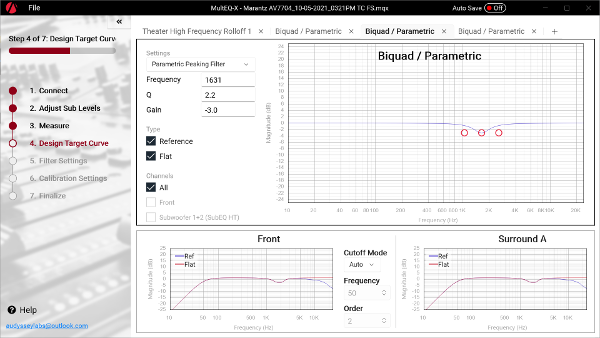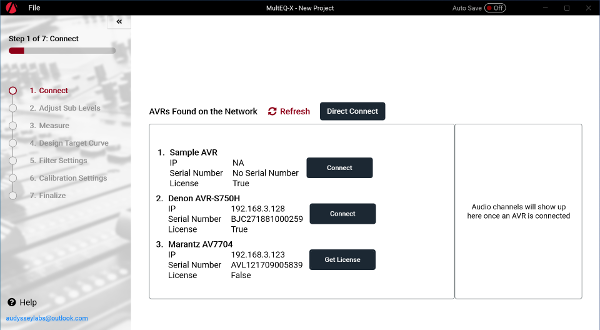Audyssey’s Acoustic Odyssey

Dealing with the effects of room acoustics is one of the biggest challenges in getting a movie or music system to sound “right.” Even the best speakers can sound awful — muted and boomy or bright and anemic — in an acoustically difficult environment. But you already know that if you’ve spent any time building a system with the goal of achieving the most realistic listening experience possible. Which brings us to Audyssey Labs, a company whose very existence is centered on delivering and continually refining technology that improves sound quality without the listener having to intervene.
If you read Sound & Vision and own a decent A/V receiver, you probably not only know of Audyssey but have used its technology to elevate the performance of your system. As Jeff Clark, director of software engineering, puts it, Audyssey’s mission is to “push any listening scenario as close to a reference listening experience as possible.” It’s a goal the company has been pursuing with great success since it introduced the first multiple-position automated room acoustic compensation system — MultEQ — 18 years ago.
 S&V: Audyssey’s MultEQ automated room-correction technology has been around since 2004 so let’s start at the beginning. Can you provide a brief overview of the company’s founding and history?
S&V: Audyssey’s MultEQ automated room-correction technology has been around since 2004 so let’s start at the beginning. Can you provide a brief overview of the company’s founding and history?
Jeff Clark: Audyssey was founded as a result of the collaboration of Tomlinson Holman (inventor of THX, Tomlinson Holman’s eXperiment, and University of Southern California (USC) Professor of Cinematic Sound), Chris Kyriakakis (USC Professor of Electrical Engineering, Signal Processing and Acoustics), Sunil Bharitkar, then a PhD student under Chris, and engineer/entrepreneur Phil Hilmes (also a USC alum, with a masters in Digital Signal Processing). Together they created MultEQ, the first automated multiple-position room acoustic compensation system. MultEQ quickly saw success in the Denon AVR-5805, which was soon upgraded to the AVR-5805CI to utilize Audyssey MultEQ Pro PC software for professional calibration.
Audyssey later expanded into other home cinema sound technologies. Dynamic EQ, for example, is a psychoacoustic compensation that maintains reference tonal balance at reduced master-volume settings by automatically managing volume levels to ensure the quieter parts of the film soundtrack aren’t lost when the volume is reduced. Several other Audyssey technologies also help optimize cinema and home cinema listening experiences.
In 2009, Audyssey MultEQ was selected by IMAX as the acoustic compensation technology used to tune its theater installations. In 2010, MultEQ XT32 took room correction to the next level, offering unprecedented precision for room-compensation filters. There were several forays into other home audio product categories, including an award-winning iPod dock, compact stereo speakers, an iPhone app for tuning headphones, and more. With the recent introduction of MultEQ-X, Audyssey has returned to its roots with software that enables delivery of new room-acoustic compensation technologies direct to home theater installers and enthusiast users of AV receivers (AVRs).
S&V: How has the company’s philosophy or mission changed over the years?
Clark: Audyssey has always worked to push any listening scenario — from cinema, home theater, stereo, headphones, car, and TV to those involving mobile devices and smart speakers — as close to a reference listening experience as possible. One philosophy that has changed a bit in recent years is that the company now offers greater customization of the sound. Users may have a preference that goes beyond reference, and this philosophy is core to our new MultEQ-X application. Reference is still the default target, but individual preference is given greater priority than in the past.
S&V: So MultEQ-X was announced just over a month ago. My understanding is that it brings greater control over calibration parameters to many AVRs that incorporate MultEQ equalization. Tell us about it. How does it work and what features and capabilities does it bring to the table?
Clark: MultEQ-X was created as a platform for Audyssey to bring its latest and greatest ideas for MultEQ room correction directly to professional installers and enthusiast consumers. It offers several major benefits:
• Measurements show detailed data — every speaker in every position can be viewed in sharp detail, with or without smoothing.
• You can now measure and re-measure individual channels instead of having to measure all output channels — two through 13 — in a single sequence. This feature is supported only in top-tier AVRs.
• Target Curve editing now includes parametric controls, including peaking, shelving high/low-pass, and many other profiles. This is not parametric equalization but rather parametric control for the target design of the Finite Impulse Response, or FIR, filtering MultEQ uses. Audyssey is still FIR only. [More on FIR in a moment.]
• You have custom control over “Flat” vs. “Reference” EQ presets — these no longer have to mean what they say.
• Bass control has been improved so you can now override the default way MultEQ handles the lower limits of a speaker or subwoofer’s frequency range. This can be helpful in situations with custom speakers that can perform at lower frequencies than MultEQ detects.
• Calibrated microphone support. Compatible microphones are expected to be available by the end of March.

We’re proud of these improvements.
We had two major goals in releasing MultEQ-X. First, give more control to installers and enthusiasts — our first release delivers complete control over the EQ process. Second, make it possible for Audyssey to deliver new technology directly to installers and enthusiasts. New features and improvements will be added over time.
The mechanics of MultEQ-X are similar to the MultEQ Editor App authored and published by Denon/Marantz and available in the Google Play and Apple stores, but MultEQ-X is written and published solely by Audyssey Labs with support from Denon/Marantz. MultEQ-X works by controlling the AVR measurement process and then downloading the measurement data to a PC where it can be displayed in rich detail and calculations performed with a more powerful processor. The final result — the EQ filters — are transferred back to the AVR and applied to the audio.
S&V: Which MultEQ-capable receivers does MultEQ-X support and how will that evolve over time?
Clark: MultEQ-X currently supports most Denon/Marantz AVRs and preamp processors. A complete list is available in the Microsoft Store. [Click here for the list.] We anticipate bringing support for more systems to MultEQ-X in the future. The software is designed with a plug-in approach that enables us to add support for different types of devices and measurement methods over time.
[Editor’s Note: Audyssey MultEQ-X is available for download at the Microsoft Store. A license must be acquired through an in-app purchase of $200, which entitles the user to calibrate a single AVR for the lifetime of the AVR. Licenses are per-user/AVR serial number and are non-transferrable. Supported systems run a 64-bit version of Microsoft Windows 10, with the October 2018 Update or later installed (Version 1809 / Build 17763). This includes the newly released Windows 11. Audyssey says support for more systems will be added in the future.]

S&V: Thanks for the overview. Very impressive. Speaking a bit more broadly, how widespread is Audyssey technology these days?
Clark: As mentioned, Audyssey MultEQ technology is present across almost the entire line of Denon and Marantz AVRs and preamp/processors. McIntosh Labs selected MultEQ XT32 for its all-digital MX100 A/V processor. And IMAX continues to tune with MultEQ XT32 in its cinemas. Jaguar/Land Rover and other automobile manufacturers tune with Audyssey and incorporate additional technologies in their vehicles. We see MultEQ-X as an opportunity to expand this, as it simplifies the incorporation of MultEQ by allowing manufacturers to offload the number crunching to a computer.
Audyssey MultEQ has always used a type of filtering called Finite Impulse Response (FIR) that has a precisely defined time response, as opposed to using Infinite Impulse Response (IIR) filters, which have an impact on the sound that can “ring down” for a very long time. Examples of IIR filters are graphic equalizers, which have a small number of fixed frequency points, or parametric equalizers, which have a small number of points with adjustable frequency. By contrast, FIR filters offer hundreds or thousands of points of control. MultEQ XT32 takes this a step further by redistributing the control to where it’s needed most — with more control points in the bass than typical FIR systems can achieve.





























































